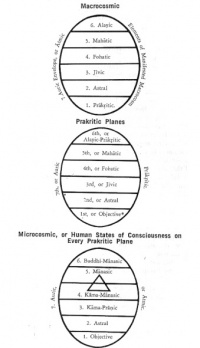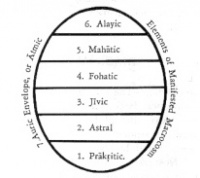Diferencia entre revisiones de «Plano»
traducción |
Sin resumen de edición |
||
| Línea 1: | Línea 1: | ||
'''Plano''' es un termino que en algunas filosofías esotéricas y espirituales es utilizada para referirse a una localidad o dimensión, que puede se física o no-fisica. La fuente original de la palabra "plano" en este contexto parece ser el último [[Neoplatonismo|Neoplatónico]] [[Proclus]], quien frecuentemente uso la palabra ''platos'' (πλάτος) que significa "amplitud, anchura, extensión, espaciosidad,", como en la expresión ''en to psuchiko platei''.<ref>J. J. Poortman, ''Vehículos de Consciencia'' vol. II (Utrecht, Países Bajos: La Sociedad Teosófica en los Países Bajos 1978), 54</ref> | '''Plano''' es un termino que en algunas filosofías esotéricas y espirituales es utilizada para referirse a una localidad o dimensión, que puede se física o no-fisica. La fuente original de la palabra "plano" en este contexto parece ser el último [[Neoplatonismo|Neoplatónico]] [[Proclus]], quien frecuentemente uso la palabra ''platos'' (πλάτος) que significa "amplitud, anchura, extensión, espaciosidad,", como en la expresión ''en to psuchiko platei''.<ref>J. J. Poortman, ''Vehículos de Consciencia'' vol. II (Utrecht, Países Bajos: La Sociedad Teosófica en los Países Bajos 1978), 54</ref> | ||
== | == Definición == | ||
[[H. P. Blavatsky]] | [[H. P. Blavatsky]] definió la palabra ''plano'' como sigue:: | ||
<blockquote>''' | <blockquote>'''Plano'''. De la palabra Latina planus (nivel, plano) una extensión de espacio o de algo en él, ya sea físico o metafísico, por ejemplo, un “plano de consciencia”. Tal como se usa en Ocultismo, el término denota el rango o extensión de algún estado de conciencia, o del poder de percepción de un conjunto particular de sentidos, o de la acción de una fuerza particular, el estado de materia correspondiente a cualquiera de las anteriores.<ref>Helena Petrovna Blavatsky, ''Glosario Teosófico'' (Krotona, CA: Theosophical Publishing House, 1973), 6.</ref></blockquote> | ||
[[Annie Besant]] | [[Annie Besant]] explicó: | ||
<blockquote> | <blockquote>Un plano puede definirse como un estado marcado por características claras; no debe ser pensado como un lugar, [Página 9] como si el universo estuviera hecho por cascaras una dentro de la otra como las capas de una cebolla. La concepción es metafísica, no física, la consciencia actuando en cada plano de manera apropiada para cada plano.<ref>Annie Besant, ''Un Bosquejo Aproximado de la Teosofía'' (Adyar, Madras: Theosophical Publishing House, 1921), ???.</ref></blockquote> | ||
== Seven planes == | == Seven planes == | ||
Revisión del 21:18 24 feb 2023
Plano es un termino que en algunas filosofías esotéricas y espirituales es utilizada para referirse a una localidad o dimensión, que puede se física o no-fisica. La fuente original de la palabra "plano" en este contexto parece ser el último Neoplatónico Proclus, quien frecuentemente uso la palabra platos (πλάτος) que significa "amplitud, anchura, extensión, espaciosidad,", como en la expresión en to psuchiko platei.[1]
Definición
H. P. Blavatsky definió la palabra plano como sigue::
Plano. De la palabra Latina planus (nivel, plano) una extensión de espacio o de algo en él, ya sea físico o metafísico, por ejemplo, un “plano de consciencia”. Tal como se usa en Ocultismo, el término denota el rango o extensión de algún estado de conciencia, o del poder de percepción de un conjunto particular de sentidos, o de la acción de una fuerza particular, el estado de materia correspondiente a cualquiera de las anteriores.[2]
Annie Besant explicó:
Un plano puede definirse como un estado marcado por características claras; no debe ser pensado como un lugar, [Página 9] como si el universo estuviera hecho por cascaras una dentro de la otra como las capas de una cebolla. La concepción es metafísica, no física, la consciencia actuando en cada plano de manera apropiada para cada plano.[3]
Seven planes

The Theosophical literature postulates that the universe is seven-fold:
Our philosophy teaches us that, as there are seven fundamental forces in nature, and seven planes of being, so there are seven states of consciousness in which man can live, think, remember and have his being.[4]
This septenary structure repeats itself at the level of the universe, the solar system, the earth, the human being, etc. Although the higher universal planes are beyond the human conception, the lower are within the range of human endeavor:
Believing in seven planes of Kosmic being and states of Consciousness, with regard to the Universe or the Macrocosm, we stop at the fourth plane, finding it impossible to go with any degree of certainty beyond. But with respect to the Microcosm, or man, we speculate freely on his seven states and principles.[5]
Macrocosmic or Solar planes
H. P. Blavatsky described the manifested universe and everything in it as being sevenfold. She claimed the states of consciousness in the universe as a whole (frequently called "Kosmos" by her) was beyond the possibility of explanation. Therefore, she limited herself to describe the seven principles in the solar system (called macrocosmos) which are reflected in human beings (microcosmos):
The student will observe that the study of the States of Consciousness is confined to Consciousness as manifesting in the solar system. Any attempt to figure Consciousness in KOSMOS would have deceived the student by inducing him to believe that such Kosmic Consciousness could be explained, whereas the whole of even the lowest plane of Kosmos transcends the highest Adept on earth.[6]

7th- Auric envelope or Atmic: This is the Cosmic Auric Egg, also called Hiraṇyagarbha
6th- Ālaya: The Universal Soul or Oversoul.
5th- Mahat: The Universal Mind or Divine Thought.
4th- Fohat: The Cosmic Energy
3rd- Jiva: The Universal Life.
2nd- Astral: The Astral model, reflecting on the lower planes.
1st- Prakiti: The physical plane of the solar system, which is again divided into seven sub-planes.
This diagram represents the type of the solar system.
The three higher divisions of this plane are inconceivable to us, and are only reached by the highest Adept in Samâdhi. Esoterically, Samâdhi is the highest state on earth attainable while in the body. Beyond that the Initiate must become a Nirmânakâya. The highest Adept begins his Samâdhi on the fourth macrocosmic plane, and cannot pass out of the solar system. When such an Adept begins his Samâdhi, he is on a par with some of the Dhyâni-Chohans, but transcends them as he rises to the seventh plane, Nirvâna.
The “SILENT WATCHER” [see The Secret Doctrine, Vol. I, pp. 207, 208] is on the fourth plane.
The Pratyeka-Buddha, the Buddha of Selfishness––called because of this spiritual selfishness “the rhinoceros,” the solitary animal––can never pass beyond the third plane, that of Jîva. Such a one has conquered, indeed, his material desires, but he has not yet freed himself from his mental and spiritual longings. It is the Buddha of Compassion only that can transcend this third macrocosmic plane.[7]
Although human beings cannot perceive these higher planes, there is a correspondence between them and his principles, and therefore, he can experience their reflection on his own level:
These seven planes correspond to the seven states of consciousness in man. It remains with him to attune the three higher states in himself to the three higher planes in Kosmos. But before he can attempt to attune, he must awaken the three “seats” to life and activity.[8]
Prakritic planes
The lowest, or first, macrocosmic plane is called "prakritic":
Prakriti, the lowest plane of macrocosmic consciousness, represents the “body” of the solar systems, with its own seven subdivisions, or the seven states of Prâkritic consciousness, each corresponding to a state of the macrocosmic consciousness.[9]
This plane is also divided into seven sub-planes, as follows:
7th
6th, or Alayic-Prakritic
5th, or Mahatic
4th, or Fohatic
3rd, or Jaivic
2nd, or Astral
1st, or Objective (Terrestrial)
- ↑ J. J. Poortman, Vehículos de Consciencia vol. II (Utrecht, Países Bajos: La Sociedad Teosófica en los Países Bajos 1978), 54
- ↑ Helena Petrovna Blavatsky, Glosario Teosófico (Krotona, CA: Theosophical Publishing House, 1973), 6.
- ↑ Annie Besant, Un Bosquejo Aproximado de la Teosofía (Adyar, Madras: Theosophical Publishing House, 1921), ???.
- ↑ Helena Petrovna Blavatsky, Key to Theosophy, (London: Theosophical Publishing House, 1987), 89.
- ↑ Helena Petrovna Blavatsky, Key to Theosophy, (London: Theosophical Publishing House, 1987), 90.
- ↑ Helena Petrovna Blavatsky, Collected Writings vol. XII (Wheaton, IL: Theosophical Publishing House, 1980), 657.
- ↑ Helena Petrovna Blavatsky, Collected Writings vol. XII (Wheaton, IL: Theosophical Publishing House, 1980), 658-659.
- ↑ Helena Petrovna Blavatsky, Secret Doctrine vol. I, (Wheaton, Ill: Theosophical Publishing House, 1993), 199
- ↑ Helena Petrovna Blavatsky, Collected Writings vol. XII (Wheaton, IL: Theosophical Publishing House, 1980), 659.